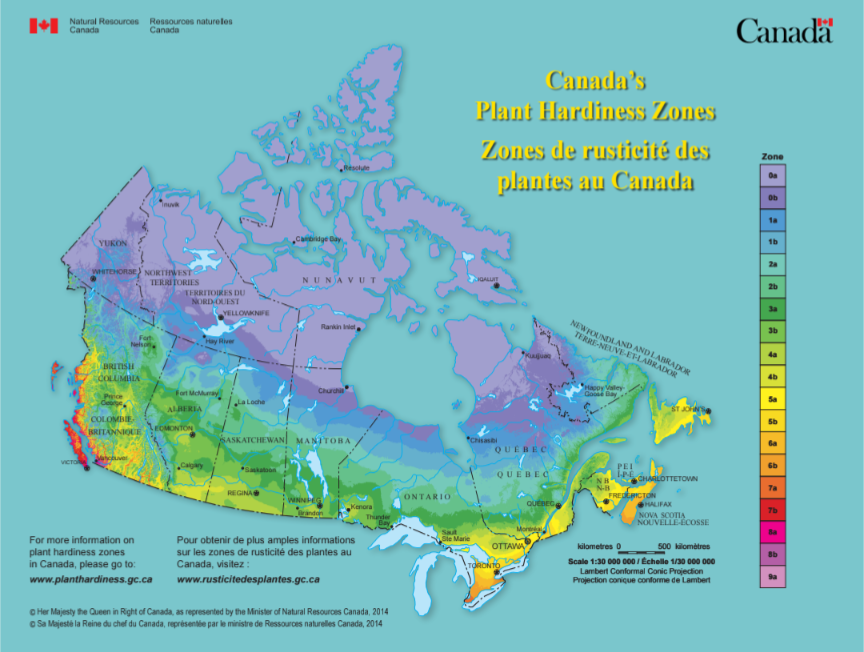
Canadian Hardiness Zones
Understanding the Canadian Hardiness Zones of Saskatchewan
Canada's geography encompasses a range of climates, from the Arctic conditions to milder maritime environments. Understanding our growing conditions in different regions is essential for gardeners and agricultural enthusiasts, as it helps us in selecting plants that can thrive. The hardiness zones are a crucial guide to this, providing insight into the climatic conditions of various areas.
What Are Hardiness Zones?
The Canadian hardiness zone system is based on a variety of factors, including minimum temperatures, frost-free periods, humidity, and precipitation. These zones, numbered from 0 to 9, give an indication of how well plants will survive the winter. Zone 0 is the coldest, where plants must withstand the harshest conditions, while zone 9 is the mildest. Within each zone, there are subzones (a and b) to denote further differences in climate, with ‘a’ indicating cooler areas and ‘b’ slightly warmer ones.
Saskatchewan’s Hardiness Zones
Saskatchewan is known for its cold winters and hot summers, making it a province where hardy plants are a necessity. The province is generally classified within hardiness zones 0 to 4, with the central and southern areas having more favorable conditions for gardening and agriculture.
1. Zone 0 (Northern Regions): The northernmost parts of Saskatchewan, such as the boreal forests near the border with the Northwest Territories, fall within zone 0. This is a region of short growing seasons and very cold winters, making it difficult for most crops or garden plants to survive.
2. Zone 1 (Far North): As you move slightly south, the northern parts of the province like La Ronge fall within zone 1. Even here, gardening is extremely limited, with plants needing to withstand winter temperatures of -45°C or colder.
3. Zone 2 (Central Regions): A large portion of central Saskatchewan, including areas like Prince Albert, Saskatoon, and surrounding farmland, lies in zone 2. This zone is better suited for hardy perennials and cold-tolerant crops. Winters are still harsh, but the growing season is long enough for certain crops like barley, wheat, and certain vegetables.
4. Zone 3 (Southern Saskatchewan): Cities like Regina and Moose Jaw are in zone 3. The winters remain cold, but the growing season is longer, making it more suitable for a wider variety of crops, trees, and shrubs. Here, gardeners can grow many types of vegetables, perennials, and some fruit-bearing plants like apples and raspberries.
5. Zone 4 (Southwestern Saskatchewan): The southwestern corner of the province, near Maple Creek and Swift Current, is in zone 4. This is one of the warmest regions in Saskatchewan, with longer growing seasons and milder winters, making it suitable for a wider range of plants, including some less hardy species.
Choosing Plants for Your Zone
When selecting plants for your garden in Saskatchewan, it's important to consider the hardiness zone you're in. Plants labeled for your specific zone (or one zone lower) are more likely to thrive and survive winter conditions. Some common hardy plants for these zones include:
- Perennials: Coneflowers, daylilies, sedum, and hostas are great options for zone 2-4 regions.
- Vegetables: Cold-tolerant vegetables like carrots, potatoes, peas, and kale do well in zones 3 and 4.
- Fruit Trees: Hardy varieties of apples, cherries, and crabapples can grow in zones 3 and 4.
- Shrubs and Trees: Evergreen species such as spruce and pine, along with hardy deciduous trees like maples and aspens, are suitable for most of these zones.
When choosing plants, you should also consider your micro-climate. If you space is located within a protected area of Hardiness Zone 3, the micro-climate may be more comparable to a Zone 4, offering more variety for plant options.
Saskatchewan offers diverse climates for gardeners, ranging from the harsh cold of the northern regions to the warmer, more hospitable zones in the south. Understanding the hardiness zones of your area is key to selecting the right plants that can survive and thrive through the seasons. With proper planning and the right plant choices, gardening in the prairie provinces can be both rewarding and fruitful.
By using the hardiness zone system as your guide, you can ensure that your garden flourishes, even in the challenging climates of Saskatchewan.

